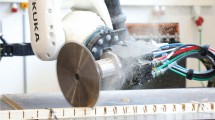Abstract
In this paper, a novel component that enables expansion for wide workspace and contraction for portability is developed. A prototype of potable robot using the expansion and contraction component is fabricated. The robot structure is made of wireframe based on Mandala (Flexi-Sphere), a geometric toy from ancient India. Experiments are carried out and the transformation and the flexible deformation of the robot by wire driving is confirmed. A potential of the robot is shown.
Access provided by Autonomous University of Puebla. Download conference paper PDF
Similar content being viewed by others
Keywords
1 Introduction
Recently, many kinds of robots become closer to people such as vacuum cleaning robots, communication robots, drones and so on. Robots that have the portability and the wide workspace as well as the safety are required.
Since an inflatable robot arm using air pressure [1, 2] is light-weight and flexible, it is a promising robot close to humans. However, a compressor is needed and air leakage is concerned.
Some robots that use the characteristic of geometric shape are proposed. Most of the geometric robots use the characteristic of changing the shapes. In [3], the robot exterior using Origami theory is changed. A thread-actuated origami robot made with paper was developed in [4]. Moreover, manipulation and locomotion were demonstrated. In [5], the tensegrity structure is used to move by rolling. The designing method that makes it easy to fold up a solid figure is developed [6]. Many kinds of geometric robots are presented which allow flexible locomotion such as an above tensegrity robot [5] and snake-like robots [7, 8].
We focused on Mandala’s structural transformation. Mandala (Flexi-Sphere) is a geometric toy from ancient India. The original Mandala has 3 degrees of freedom and can transform to several shapes such as sphere, cylinder, disk, and gourd-shaped as shown in Fig. 1. The 3 dof consists of 1 dof at the middle layer for expansion and contraction and 2 dof at the both ends for open and close. In our previous research [9], we increase the dof from 3 to 9 in order to change the shape more variously.
In this paper, a novel wireframe component that enables expansion for wide workspace and contraction for portability is developed, which is inspired from the original Mandala. A prototype of potable robot using the expansion and contraction component is fabricated. Since the robot structure is made of wireframe, the robot can be light-weight and flexible. Experiments are carried out and the transformation and the flexible deformation of the robot by wire driving is confirmed. A potential of the robot is shown.
2 Parameter Analysis of Mandala
To find the configuration and size appropriate to the specifications for the expansion and contraction component, we parameterize Mandala geometrically. Figure 2 shows the elements of Mandala. We name the center circle of Mandala, which is a perfect circle, “CC” and the semi-circle around CC, which is oval, “SC”, respectively. The geometric parameters of Mandala are shown in Fig. 3. The definitions are listed in Table 1.
The appropriate values of parameters are derived to achieve large ratio of expansion and contraction as follows. First, according to the characteristics of Mandala, we assume the following conditions.
In addition, to set the position of joints between CC and SC to be equal interval on CC, and the following equations are assumed.
Next, we consider the number of SC N. Ordinary Mandala has 7 to 9 SCs in a CC. We made some prototypes of Mandala that had the different number of SC. When the number of SC in a CC was 11, the shape of Mandala became relatively hard to change. It was because the interference of SC made it difficult to rotate around CC. For the moderate motion, we decided \(N<12\). Because of the conditions of \(\alpha \) and \(\beta \), Eqs. (1), (3) and (4), and the characteristics of Mandala prototype, the candidates of N were chosen as below:
In case of \(N=9\), especially, the SCs can be divided into 3 parts, and the Mandala becomes symmetry. The symmetry makes it easy to use and set the supports and driving mechanisms. Therefore, we decided the number \(N = 9\).
As a result, the numbers of \(\alpha \) and \(\beta \) were derived as follows:
We decided that the diameter of CC was 100 [mm] (the radius \(R=50\) [mm]) and the radius of major axis of SC was \(a=70\) [mm]. Then, b and x were derived as follows:
3 Development of Expansion and Contraction Mechanism and Robot
3.1 Expansion and Contraction Component
A prototype of expansion and contraction component was fabricated based on the parameters listed in Table 1. The component was made of stainless steel wire whose diameter was \(\phi 2.0\). Figure 4(a) shows the top view of the component. Coil springs were used to keep the interval of joints between CC and SC, as shown in Fig. 4(b).
Torsion springs were placed at the connecting joints between SCs, which is illustrated as a blue point in Fig. 2, to avoid the singular point, as shown in Fig. 5. When the prototype robot is cylindrical shape, connecting joints bend slightly out because of the torsion springs.
Prototype robot (top view of Fig. 7(1))
3.2 Expansion and Contraction Robot
Finally, a robot using four components was developed as shown in Fig. 6. The base was made by using 3D printer. The specifications obtained from the experiment using the actual prototype robot are listed in Table 2. The ratio of expansion and contraction is nine in the direction of z axis. Its representative shapes are (1) disk, (2) cylinder and (3) gourd-shaped, and the pictures are shown in Fig. 7.
The prototype robot is motorized to control the motion. Four RC servo motors altered to allow unlimited rotation are employed. The motors rotate reels to pull nylon strings whose diameters are \(\phi \)0.369. In other words, the robot is wire driven. The wire arrangements are shown in Fig. 8.
One motor is driven for changing the robot shape to the gourd-shaped. Other three motors are driven to control the tip position of the robot. The experiments are carried out in the following sections.
4 Experiments of Expansion and Contraction Robot
In this section, some experiments using the prototype robot described in the previous section are carried out.
4.1 Expansion from State of Contraction
In case of the contraction, the prototype robot is disk-shaped as shown in Fig. 7(1), and it is easy to be carried, i.e. portable.
Once the robot is carried to the target place, the robot should be expanded. In this study, the support by human is required to expand the robot as shown in Fig. 7(2). While the human user keeps the robot to be the expansion state, one motor reels the wires up to change the shape from cylinder to gourd-shaped. Finally, the robot transforms to gourd-shaped as shown in Fig. 7(3), and the robot can be self-supported.
4.2 Contraction from State of Expansion
In contrast to the previous subsection, to change the shape from gourd-shaped to cylinder, the motor unfastens the wires. The support by human is needed in the same way. As described in the previous section, torsion springs were employed at the joints between SCs to make it easy to change to contraction. The mechanism, however, didn’t work well this time.
4.3 Deformation Motion in State of Expansion
As mentioned above, when the robot is gourd-shaped, it can be self-supported. Moreover, it is deformable because of mechanical play of joints between CC and SCs. The characteristics can be utilized to control the posture of the prototype robot with three wires. The prototype robot has no sensor such as rotary encoder and tension sensor. The tensions of three wires were manually operated with motors as a preliminary experiment. Figure 9 shows an example of changing postures. Figure 9(1) represents the initial posture of gourd-shape. Figure 9(2) demonstrates the intermediate posture to the target posture shown in Fig. 9(3). Figure 10 shows the reach length at the target posture. The tip of robot is moved to 430 [mm] away from the center of setting position.
5 Conclusions
To develop a light and compact portable robot, we focused on the Mandala’s structural transformation and deformation. Mandala was parameterized and the appropriate values were found to achieve large ratio of expansion and contraction. We developed the expansion and contraction component and a prototype robot. Expansion and contraction experiments and deformation motion were carried out, and a potential of the robot was shown.
As future works, the automatic transformation to expansion and contraction, modeling of deformation of the robot structure, the posture control of the robot, and the evaluation of performance are needed.
References
Sanan, S., Moidel, J.B., Atkeson, C.G.: Robots with inflatable links. In: Proceedings of the 2009 IEEE/RSJ International Conference on Intelligent Robots and Systems, pp. 4331–4336 (2009)
Kim, H.-J., Tanaka, Y., Kawamura, A., Kawamura, S., Nishioka, Y.: Development of an inflatable robot arm systems controlled by a joystick. In: Proceedings of the 24th IEEE International Symposium on Robot and Human Interactive Communication, RO-MAN 2015, pp. 664–669 (2015)
Sato, K., Aoki, T.: Development of flexible mobile robot with closed type crawler belt–Design of crawler belt by theory of “Origami”–. In: Proceedings of the 2014 JSME Conference on Robotics and Mechatronics, 2A2-D07 (2014). (in Japanese)
Hoff, E.V., Jeong, D., Lee, K.: OrigamiBot-I: a thread-actuated origami robot for manipulation and locomotion. In: Proceedings of the 2014 IEEE/RSJ International Conference on Intelligent Robots and Systems, IROS 2014, pp. 1421–1426 (2014)
Hirai, S., Koizumi, Y., Shibata, M., Minghui, W., Bin, L.: Active shaping of a tensegrity robot via pre-pressure. In: Proceedings of the 2013 IEEE International Conference on Advanced Intelligent Mechatronics, AIM 2013, pp. 19–25 (2013)
Kase, Y., Mitani, J., Kanamori, Y., Fukui, Y.: Flat-foldable axisymmetric structures with open edges. In: The 6th International Meeting on Origami in Science, Mathematics and Education, 6OSME (2014)
Primerano, R., Wolfe, S.: New rolling and crawling gaits for snake-like robots. In: Proceedings of the 2014 IEEE/RSJ International Conference on Intelligent Robots and Systems, IROS 2014, pp. 281–286 (2014)
Iwamoto, N., Yamamoto, M.: Jumping motion control planning for 4-wheeled robot with a tail. In: Proceedings of the 2015 IEEE/SICE International Symposium on System Integration, SII 2015, pp. 871–876 (2015)
Aka, T., Takesue, N.: Development of flexi-sphere robot. In: Proceedings of the 15th SICE System Integration Division Annual Conference, 2H1-2 (2014). (in Japanese)
Author information
Authors and Affiliations
Corresponding author
Editor information
Editors and Affiliations
Rights and permissions
Copyright information
© 2016 Springer International Publishing Switzerland
About this paper
Cite this paper
Takei, Y., Takesue, N. (2016). Design of Wireframe Expansion and Contraction Mechanism and Its Application to Robot. In: Kubota, N., Kiguchi, K., Liu, H., Obo, T. (eds) Intelligent Robotics and Applications. ICIRA 2016. Lecture Notes in Computer Science(), vol 9834. Springer, Cham. https://doi.org/10.1007/978-3-319-43506-0_9
Download citation
DOI: https://doi.org/10.1007/978-3-319-43506-0_9
Published:
Publisher Name: Springer, Cham
Print ISBN: 978-3-319-43505-3
Online ISBN: 978-3-319-43506-0
eBook Packages: Computer ScienceComputer Science (R0)














